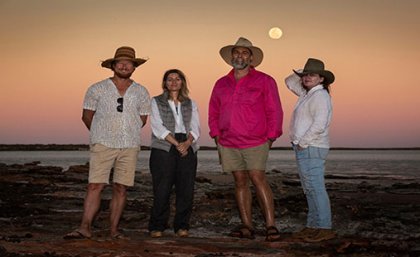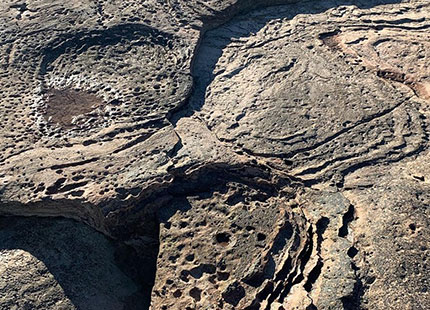
An award-winning French video artist and sculptor has teamed up with a University of Queensland palaeontologist to showcase the dinosaur tracks of Western Australia’s Kimberley region.
UQ’s Dr Steven Salisbury is working with artist Angelika Markul as part of the innovative visual arts project ‘On the Trail of Dinosaurs’.
Dr Salisbury, whose research helped secure and reinforce National Heritage Listing for the dinosaur tracks of the Dampier Peninsula, said he hoped Angelika’s art would make the region’s natural and cultural heritage more accessible to a wider audience.
“People appreciate the dinosaur tracks of the Dampier Peninsula for many different reasons, be they scientific, cultural or aesthetic,” Dr Salisbury said.
“I think what makes them really special is the combination of all of those things.”
The project, due for completion in 2020, will feature a video installation and replicas of selected dinosaur tracks, made by researchers at UQ’s Dinosaur Lab, which Markul will re-cast in bronze.
Last month, Dr Salisbury spent five days on the Dampier Peninsula near Broome, with the artist, her curator and Kimberley-based filmmaker Mark Jones, immersed in all things ‘Dinosaurian’.
“Logistically, it’s very tricky to access the tracks due to their remoteness and preservation in the intertidal zone, but it was crucial for Angelika to see and experience them in their natural setting,” Dr Salisbury said.
“We were welcomed to the tracks by elders from Goolarabooloo and Yawuru at a beach where the dinosaur tracks form part of a Dreamtime story about Marala, the Emu Man.
“The indigenous people of the region have a deep cultural connection with the tracks, and it was important for Angelika to experience this connection first hand.”
Ms Markul said she was moved by what she described as a spiritual experience.
“This journey was like a pilgrimage,” she said.
“I was completely overwhelmed — we were at the heart of history, at the heart of our beginning, of our origin.
“The intact nature of the dinosaur tracks and the fact that they still exist was impressive, but I was enthralled with their connection to Aboriginal culture.”
 The team visited multiple locations along the Kimberley coast that showcased the diversity of tracks and their ancient, wild aesthetic.
The team visited multiple locations along the Kimberley coast that showcased the diversity of tracks and their ancient, wild aesthetic.
“What I found most fascinating about the whole experience was Angelika’s quite different perspective,” Dr Salisbury said.
“I’d look at the tracks and think about the dinosaurs that made them, and what the area would have looked like back then.
“But Angelika looked at them and marvelled at the colours and textures, little things I often overlook or take for granted.”
“It’s a long way from the Kimberley to Paris, and my hope is that Angelika’s art brings the magic of these tracks to a new audience, and lets them experience and appreciate them from afar.”
Image above: Ripples in time: weathered sauropod dinosaur tracks on Reddell Beach. Credit: Angelika Markul.
Media: Dr Steven Salisbury, s.salisbury@uq.edu.au, +61 407 788 660; Dominic Jarvis, dominic.jarvis@uq.edu.au, +61 413 334 924.
.jpg)












